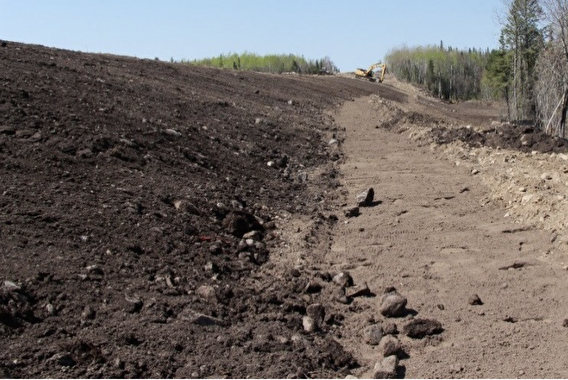
According to the second phase of a multi-year study, recycled commercial and industrial waste is an effective option for biofilter material in stormwater control installations—and it can help reduce costs, too.
Biofilters are an important tool to contain and filter pollutants in roadway runoff. They are used in low-impact installations such as bioslopes and bioswales—shallow ditches at the bottom of bioslopes—that mimic the natural landscape.
In the first phase of the study, researchers investigated the use of local materials for bioslopes in northeastern Minnesota. That work, by researchers in the Natural Resources Research Institute (NRRI) at the University of Minnesota Duluth, examined the use of peat and muck from local construction projects and taconite tailings left over from the mining industry.
Typically, the media used to filter pollutants is made from imported compost and sand, which can be costly to transport. Researchers wanted to find a recycled, local alternative to save on transportation costs and reduce waste.
The original study generally found that the best recipe for biofilter media is a combination of peat (partially decomposed plant matter) and taconite tailings. An initial two years of monitoring indicated that these materials performed as well as an imported mix of compost and sand in terms of water absorption, pollutant retention, and plant growth.
In phase two of the project, led by NRRI environmental engineer Meijun Cai, researchers continued to study the long-term performance of these materials. “This project’s extended monitoring provides more data for stormwater application design and management using salvage materials,” Cai says. “It will support and promote smarter and more economical material reuse strategies.”
Cai’s team found that water retention capacity, for the most part, remained steady over three years (2018–2020). There were some variations: One of the two test sites displayed a drop-off in water retention capacity after the first year, likely due to soil compaction from equipment and snow loading. However, the biofilters remained successful overall in capturing the first inch of stormwater runoff (a requirement by the Minnesota Pollution Control Agency for new impervious pavement).
Water quality varied much more significantly over time, Cai says. Recycled peat tended to leach phosphorous at the beginning of the installation’s lifespan; this dropped off over time because of plant uptake and depletion of phosphorous from the filter material.
Imported compost mixed with taconite tailings was also tested over two years for comparison. Researchers found that it behaved similarly to peat—overall steady water retention capacity but a tendency to leach a relatively high amount of phosphorous.
The researchers determined that the ideal way to use recycled peat is by limiting the organic ratio of the soil mixture to 20 percent or less. They recommend a mix that includes 10 percent recycled peat and 10 percent imported compost. They also recommend using a limited amount of taconite tailings to mitigate metal leaching.
Going forward, the researchers recommend continued monitoring of the test sites and an examination of the soil media after five or more years to determine present and future maintenance costs.
“The reuse of local-sourced filtration media generated within project limits—that would otherwise be discarded as waste—as an alternative to shipped-in new materials in engineered bioslope installations has been a success,” says Dwayne Stenlund, erosion control specialist with MnDOT and technical liaison for the project.
Both the initial project and the follow-up monitoring were sponsored by the Minnesota Department of Transportation.
Writer: Sophia Koch